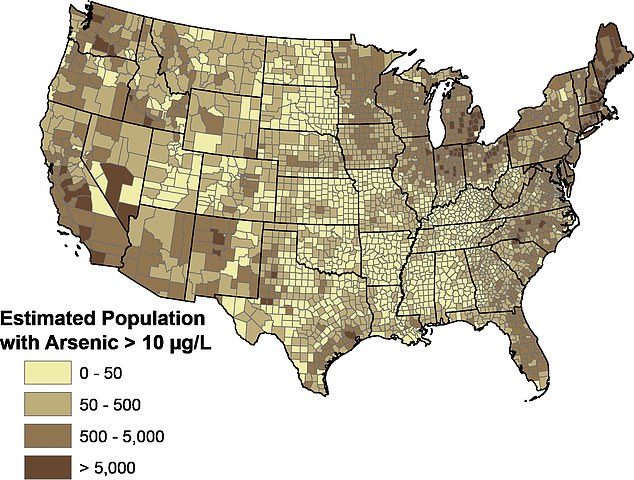A massive new study has linked a colorless, odorless and tasteless metal found in drinking water in the US with an increased risk of heart disease.
Columbia researchers examined the health records of 100,000 Californians over 23 years and compared them to their estimated exposure to arsenic in drinking water.
They found that people exposed to high levels of the toxic metal for a decade or more were 42 percent more likely to develop heart disease, even when controlling for factors such as high blood pressure, smoking and exercise habits.
Even drinking water containing less than the EPA’s 10 parts per billion limit over time led to a five to 20 percent increased risk of heart disease.
This, said study author Dr. Tiffany Sánchez, an environmental and molecular epidemiologist, suggests that current policy on the amount of arsenic allowed in drinking water may need to be reexamined.
Dr Sánchez said: “Our results are novel and encourage renewed debate about current policies and regulatory standards.”
This map from the United States Geological Survey estimates the parts of the country with the highest levels of naturally occurring arsenic in private drinking wells.
Dr Sánchez said: “This study is one of the first to comprehensively describe the risks at exposure levels below the current regulatory limit.”
It’s not clear how arsenic can cause heart problems, but older animal studies have shown that it can cause inflammation that affects the shape of the blood vessels leaving the heart.
Changes in the shape of these blood vessels can affect the way blood flows and cause damage to the organ over time.
Arsenic is a naturally occurring heavy metal found in the Earth’s crust and can reach air, water and soil.
It is most concentrated in the groundwater of New England, the northern Midwest and parts of the West. California is one of those states.
The most common way people are exposed to metal is through drinking water, according to the National Institute of Environmental Health Sciences.
People who use private wells for drinking and do not test regularly for arsenic are at much higher risk than those who get their water from a community water supply.
The Environmental Protection Agency estimates that these companies supply drinking water to 90 percent of Americans.
When someone is exposed to this tasteless, colorless, and odorless product in large quantities over a long period of time, it can cause damage to their cardiovascular, immune, and endocrine systems. It can also accumulate in the liver, kidneys, prostate, and bladder.
Still, researchers aren’t sure how much arsenic exposure can lead to heart disease over time.
The new study, which was published in the journal Environmental health perspectives conducted by researchers at Columbia University’s Mailman School of Public Health, aimed to limit that measurement.
It included an analysis of 98,250 people who participated in the California Teacher Study, which collected data from more than 100,000 teachers, nurses and other school staff from 1995 to 2018.
Tracked your lifestyle habits, location, and health outcomes over time.
The Columbia researchers excluded people over 85 and those with pre-existing heart disease. Then, they compared the teachers’ health data with maps showing the amount of arsenic found in drinking water throughout California.
They looked at both ischemic heart disease and cardiovascular disease.
Ischemic heart disease, also known as coronary artery disease, involves a reduction in blood flow to the heart due to the buildup of plaque or blood clots. According to the NIH, this is the leading cause of heart attack.
Cardiovascular disease is a general term that includes stroke, heart disease, heart failure, and peripheral artery disease.
Looking at the 6,119 cases of ischemic heart disease and 9,936 cases of cardiovascular disease, a pattern emerged linking arsenic exposure to coronary artery disease. There was no evidence of a link with cardiovascular diseases such as stroke.

In the study, they found that arsenic in water was specifically linked to coronary artery disease, but not other cardiovascular diseases, such as stroke. CAD is the leading cause of heart attack
The current EPA limit for the acceptable amount of arsenic in drinking water is 10 parts per billion (ppb) of water.
About 48 percent of the participants were exposed to less than one ppb of arsenic and the researchers found that they had no increased risk of developing heart disease. But people exposed to between one and ten parts per billion were.
When exposed to between one and five ppb, people were five to six percent more likely to develop ischemic heart disease.
When people are exposed to between five and ten ppb of arsenic, the risk of developing ischemic heart disease increases by 20 percent.
Finally, when people were exposed to levels above the EPA limit, people were 42 percent more likely to develop ischemic heart disease.
In addition to the amount of arsenic, the researchers looked at whether the amount of time someone was exposed to water with arsenic mattered. They found that the longer a person was exposed, the greater their risk.
Once they reached a decade of exposure, their risk was 18 to 20 percent higher than that of people who had been exposed to arsenic in drinking water for a shorter period of time.
These findings, although unique in their scope, are not the first to link arsenic exposure to heart disease.

Ischemic heart disease, also known as coronary heart disease or coronary artery disease, occurs when blockages in blood vessels cause reduced blood flow to the heart. This may be due to plaque buildup, a blood clot, or a narrowing of blood vessels.
A 2018 study of indigenous people living in the US found that those with higher levels of arsenic in their urine were 1.5 times more likely to have high blood pressure and thickened heart muscles.
Both of these factors are signs that the heart is under stress and can cause heart disease and disruptions in its rhythm.
Still, Dr. Sanchez said, more research is needed before doctors can conclude that arsenic causes heart problems, and doctors aren’t sure how the metal may be causing the increased risk seen in the study.
Normally, narrowing of blood vessels and plaque buildup are attributed to a poor diet, which causes cholesterol and fat to build up in the bloodstream and clog the tubes of the cardiovascular system.
It is not clear how arsenic could contribute to this.
Therefore, Dr. Sánchez concluded that his findings are a starting point for future research: “We believe that the data and methods developed in this study can be used to strengthen and inform future studies and can be expanded to evaluate other drinking water exposures. and health outcomes. .’

